Estimated Reading Time: 29 minutes (5537 words)
The moment when someone fully inhabits a character — when their voice changes, their posture shifts, and their eyes reflect someone else’s soul — is nothing short of magic.
Roleplay transcends mere game mechanics or theatrical techniques. It’s the collaborative art of becoming someone else within a safe container, where imagination can run wild without real-world consequences. For some, it’s a creative outlet; for others, a profound exploration of identity or psychology; for many, it’s simply the most engaging way to tell stories together.
Yet for all its transformative potential, successful roleplay remains elusive for many. The difference between awkward character attempts and truly immersive experiences rarely comes down to elaborate backstories or perfect accents. Instead, it hinges on something more fundamental: the invisible architecture of trust that allows people to take creative risks together.
The best roleplaying experiences happen when everyone feels secure enough to be playfully vulnerable — to try something that might fail, to express emotion that feels raw, to temporarily shed the protective layers we wear in everyday life. This psychological safety doesn’t happen by accident. It’s deliberately cultivated through practices that honor both creativity and boundaries.
Beyond techniques and tactics lies a deeper truth about roleplaying: when we step into another’s shoes, we often discover unexpected parts of ourselves. The shy person who becomes commanding when playing a general, the analytical thinker who accesses deep wells of emotion through a grieving character — these transformations reveal the expansive potential within us all. With the right approach, that potential can be safely unlocked.
Roleplay is more than just pretending to be someone else—it’s about crafting shared experiences where imagination thrives. When done well, it creates memorable moments and builds connections that transcend the game itself.
- Build psychological safety first: Before diving into character sheets and plot hooks, establish an environment where players feel comfortable taking creative risks without fear of judgment. The most immersive roleplay happens when participants trust each other enough to be vulnerable.
- Develop characters with room to grow: Create personalities with clear motivations and flaws, but leave space for evolution through play. The most compelling characters aren’t static—they respond to experiences and change over time, just like real people.
- Master the art of “yes, and”: Instead of shutting down others’ ideas, build upon them. This improvisational technique keeps scenes flowing and validates everyone’s contributions, creating richer collaborative narratives than any single person could develop alone.
- Establish boundaries before breaking them: Have open conversations about comfort zones and taboo topics before play begins. Paradoxically, clear boundaries actually create more freedom, as players can fully immerse themselves knowing they won’t accidentally cross into uncomfortable territory.
- Balance preparation with spontaneity: Come with enough background to guide your character’s decisions, but remain flexible enough to respond authentically to unexpected developments. Over-planning can be as detrimental as under-planning.
- Practice active listening: Great roleplayers spend more time responding thoughtfully to others than planning their next move. Pay attention to subtle cues in others’ performances and build upon them to create meaningful interactions.
- Separate character knowledge from player knowledge: The tension between what you know and what your character knows creates rich roleplaying opportunities. Resist using out-of-character information to gain advantages in-game.
Successful roleplay isn’t just about what happens at the table—it’s about creating an atmosphere where everyone feels empowered to contribute. The techniques we’ll explore help foster both the technical skills and psychological foundations needed for truly immersive storytelling experiences.
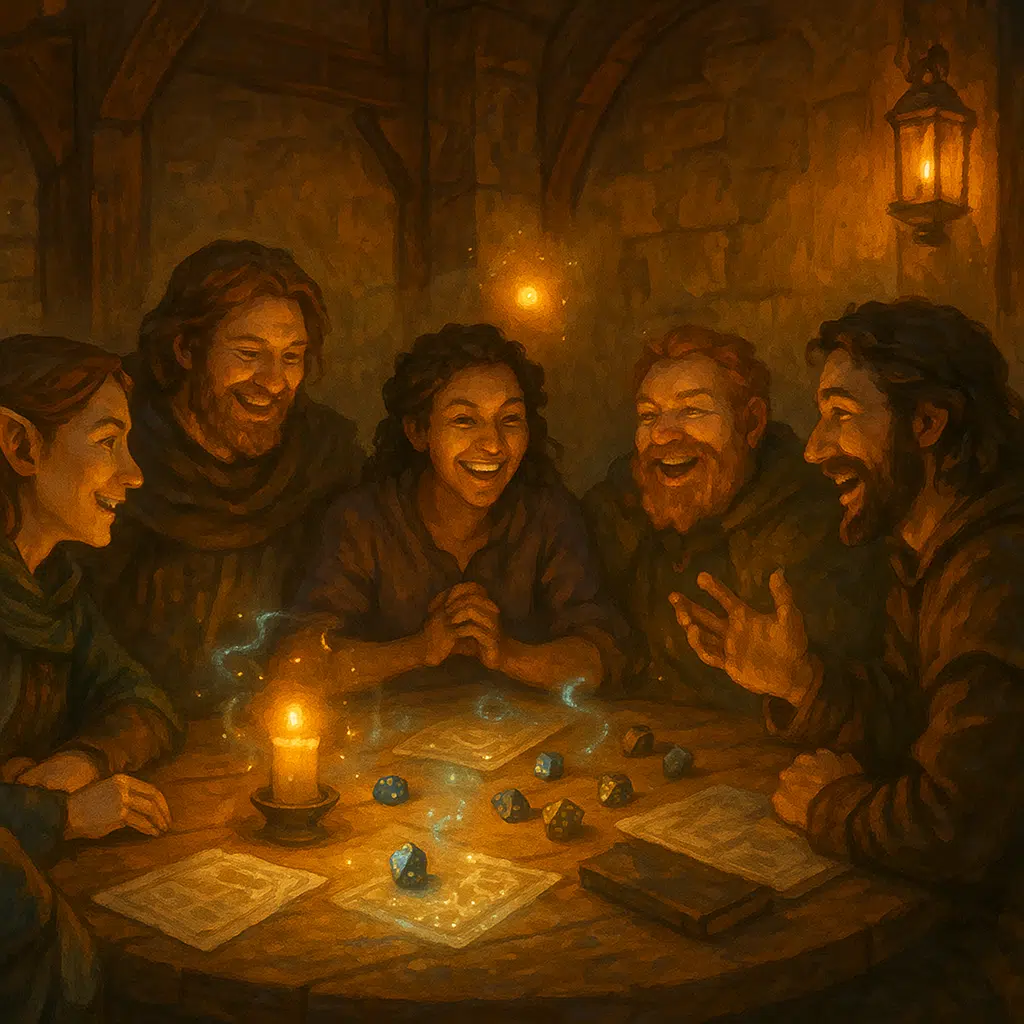
The Foundation of Psychological Safety
Creating Trust Before the First Scene
Trust doesn’t magically appear once dice start rolling or when the stage lights come on. It must be deliberately cultivated before the first character ever speaks. This process begins with simple but meaningful interactions that establish mutual respect among participants. Consider starting with a pre-game social gathering where people can connect as themselves before becoming their characters. These moments of authentic connection create the bedrock upon which creative risks can later be taken.
Another effective approach is to share personal expectations and past experiences with roleplay in a judgment-free conversation. When someone reveals, “I once felt really embarrassed when I tried a dramatic scene and it fell flat,” it gives others permission to acknowledge their own anxieties. These small moments of honesty create bridges of understanding that will later support more elaborate creative structures.
For groups new to each other, structured getting-to-know-you activities can accelerate trust formation. Even something as simple as each person sharing their favorite character from fiction and why they connect with them can reveal valuable insights into what each player values in storytelling. These glimpses into each other’s imaginative preferences establish common ground that makes subsequent collaboration more intuitive. Many game masters find that dedicating an entire Session Zero: The Foundation of Meaningful Campaigns to these trust-building conversations and boundary-setting discussions creates a stronger foundation for all the roleplay that follows.
Why Vulnerability Unlocks Better Roleplay
The most memorable roleplaying moments rarely come from flawless performance or clever tactics—they emerge when players allow themselves to be genuinely vulnerable. When a player lets their character express fear, heartbreak, or profound joy, it creates a magnetic authenticity that pulls everyone deeper into the shared reality. Yet vulnerability requires psychological safety; no one will expose their creative underbelly in an environment that feels judgmental or competitive.
This vulnerability paradox explains why some technically “skilled” roleplayers can still create flat experiences, while less polished players sometimes generate profoundly moving moments. The latter have often created spaces where imperfection is embraced rather than critiqued. A player fumbling through an emotional scene but taking the emotional risk anyway will almost always create a more compelling experience than someone executing a flawless performance while emotionally playing it safe.
Crucially, vulnerability in roleplay doesn’t mean players must share personal traumas or uncomfortable revelations. Rather, it’s about the willingness to be present with uncertainty, to take creative risks without knowing how they’ll be received, and to allow genuine emotion to inform character choices even when those emotions feel raw or imperfect.
Designing Ground Rules That Liberate Rather Than Restrict
Counter-intuitively, clear boundaries create greater freedom in roleplay. When participants know exactly what themes are welcome and which are off-limits, they can explore the permissible territory with confidence rather than hesitancy. Effective ground rules don’t feel like restrictions—they feel like clarity that enables bolder creative choices within established parameters.
These guidelines work best when framed positively rather than as prohibitions. Instead of a list of forbidden topics, consider articulating the story’s emotional territory: “We’re exploring themes of redemption, found family, and overcoming personal demons.” This approach maintains the group’s autonomy while still creating protective guardrails around sensitive content.
The most liberating ground rules address both content and process. Content boundaries might include agreements about romantic entanglements, violence, or political themes. Process guidelines, equally important, establish how players will communicate mid-game if something uncomfortable arises, how feedback will be shared, and how conflicts will be resolved. When these processes are established in advance, players can fully immerse themselves in the creative experience rather than worrying about navigational uncertainties.

The Character Creation Mindset
Balancing Defined Traits with Room for Evolution
The most compelling characters in roleplay exist in the sweet spot between being clearly defined and having room to surprise even their creators. Characters drawn with overly rigid traits often feel mechanical and predictable, while those left too undefined can lack the coherence needed for believable development. The art lies in creating a strong foundation that still allows for organic growth.
Consider defining your character’s core values, formative experiences, and immediate goals—but intentionally leave questions about how they might react in unfamiliar situations. A merchant who values family above all else has a clear motivational compass, but how that value manifests when faced with unexpected moral dilemmas creates space for discovery through play. These emergent moments often become the most memorable aspects of character development.
Many experienced roleplayers recommend the “three traits plus a contradiction” approach. Define three consistent aspects of your character, then add one element that seemingly contradicts them. A ruthlessly practical survivalist who inexplicably collects beautiful but useless trinkets. A shy academic who becomes fearlessly outspoken when defending historical accuracy. These internal tensions create dynamic characters who can evolve in believable yet surprising ways. For writers and game masters looking to develop this character complexity further, the principles of Creating Authentic Character Profiles That Drive Your Story’s Emotional Core can be adapted to roleplay contexts, helping build characters with psychological depth that enhances table dynamics.
Finding Your Character’s Voice and Physical Presence
A character truly comes alive when they have distinctive vocal patterns and physical mannerisms that differentiate them from their player. These elements need not be dramatic or performative—subtle shifts in posture, pacing of speech, or habitual gestures can be remarkably effective at signaling character embodiment. The goal isn’t theatrical perfection but consistent markers that help everyone at the table recognize when you’re speaking as your character versus as yourself.
Voice transformation doesn’t require accent work (though accents can be fun if you enjoy them). Consider instead how your character’s personality might affect their speech patterns. Do they speak in complete, carefully constructed sentences or in fragmented, urgent phrases? Do they use flowery vocabulary or blunt, direct language? Do they interrupt frequently or listen more than they speak? These choices communicate character more authentically than an accent that might slip during emotional moments.
Physical presence can be established through posture alone. A character who takes up space confidently versus one who attempts to make themselves smaller. A character who gestures expansively versus one who keeps their hands close to their body. These embodied choices not only signal to others who you’re portraying but can also trigger your own psychological shift into character—what psychologists call embodied cognition, where physical changes influence mental state.
When Flaws Create More Interesting Play Than Strengths
The most engaging characters are often defined not by their capabilities but by their limitations and contradictions. A perfect hero who excels at everything creates few narrative possibilities. Conversely, a character with meaningful flaws generates constant opportunities for tension, growth, and unexpected resolution. Strategic imperfection is the secret ingredient of compelling roleplay.
Effective character flaws should create meaningful complications rather than simply being quirky traits. A fear of abandonment that makes a character clingy with allies creates more interesting scenarios than a harmless habit of speaking in rhymes. Similarly, flaws that occasionally force difficult choices—like a code of honor that sometimes conflicts with practical needs—generate more dramatic potential than static descriptive attributes.
The most productive flaws evolve through play rather than remaining static. A character’s initial arrogance might be humbled through failure, only for that humility to transform into a different kind of pride. This evolution through consequences creates a sense of earned character development that static strengths rarely provide. When crafting your character, consider not just who they are when the story begins, but the journey their flaws might lead them through as they face challenges specifically designed to test those vulnerabilities.
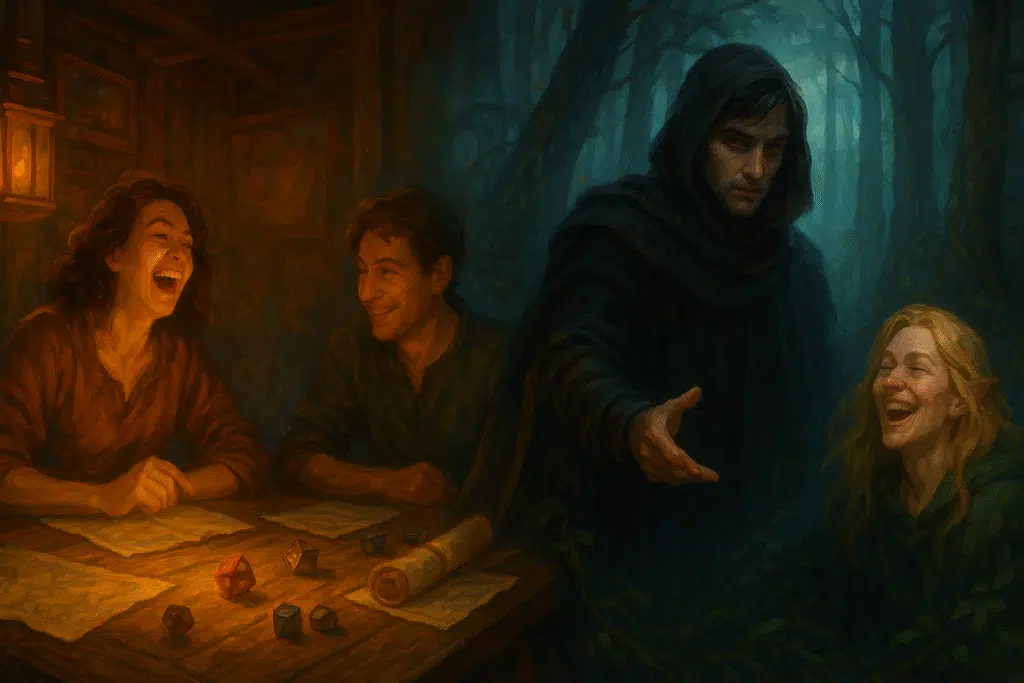
The Improvisational Heart of Roleplay
Embracing “Yes, And” in Collaborative Storytelling
At its core, roleplay is fundamentally improvisational. Even the most carefully planned scenarios inevitably take unexpected turns based on player choices and unpredictable dice rolls or rule interpretations. The principle of “Yes, And”—accepting what others contribute and building upon it—serves as the essential lubricant that keeps this collaborative machine running smoothly.
This principle doesn’t mean saying yes to everything literally. Rather, it means acknowledging the creative offering another player has made and finding ways to incorporate it constructively rather than negating it. When someone introduces an unexpected element—perhaps their normally cautious character suddenly takes a bold risk—the “Yes, And” approach looks for ways this choice might make sense rather than reasons it doesn’t. “Yes, your normally cautious character is acting boldly, and perhaps that’s because this situation has triggered something from their past we haven’t explored yet.”
The opposite of “Yes, And” isn’t just “No” but also “Yes, But”—accepting something conditionally while effectively nullifying its impact. This often manifests as technical acceptance while emotionally rejecting the offering: “Yes, you charm the guard, but he still won’t let us pass.” This approach technically acknowledges the other player’s contribution while functionally negating it, creating the same deflating effect as an outright rejection. Understanding these collaborative dynamics reflects deeper principles about how Story Mechanics Create Meaning, where the systematic elements of narrative construction work together to generate authentic dramatic tension rather than artificial conflict.
Reading the Room: Adapting to Energy Shifts
Skilled roleplayers develop a heightened awareness of the emotional current flowing through a session. They notice when energy dips, when certain themes resonate powerfully, or when a particular dynamic is creating engagement or discomfort. This emotional intelligence allows them to make micro-adjustments that keep the experience vibrant and responsive.
When attention seems to waver, consider introducing a surprising element or escalating stakes. When a certain interaction sparks genuine excitement, find ways to extend that dynamic rather than rushing to the next plot point. If an emotional scene is resonating deeply, give it room to breathe rather than cutting the tension with humor (a common but often counterproductive impulse). These adjustments don’t require derailing planned content—often small tweaks in pacing, intensity, or focus can dramatically shift the energy.
Sometimes reading the room means recognizing when players are engaging differently than expected. A carefully crafted political intrigue might unexpectedly spark players’ interest in a seemingly minor character. Rather than forcing the original direction, skilled facilitators learn to follow this emergent energy, perhaps elevating the minor character to greater significance. This flexibility honors the collaborative nature of roleplay while still maintaining narrative coherence.
Recovering Gracefully When Scenes Fall Flat
Even in the most experienced groups, some scenes inevitably fall flat. A dramatic reveal generates shrugs instead of gasps. An emotional confrontation feels forced rather than organic. A carefully planned interaction somehow misses the mark. How the group recovers from these moments often determines whether the session ultimately succeeds or fails.
The first principle of recovery is acknowledgment without dwelling. A quick “That didn’t quite land how I expected” can clear the air more effectively than pretending everything is going perfectly. This brief acknowledgment, without extensive analysis or apology, prevents the awkward energy from lingering while maintaining narrative momentum.
The second principle is pivoting rather than pushing. When a scene isn’t working, trying harder to make it work often compounds the problem. Instead, shift to a different angle or introduce a new element that might reinvigorate engagement. If the dramatic confrontation with the villain isn’t resonating, perhaps an unexpected ally or enemy appears, changing the dynamic entirely. These pivots maintain the session’s forward movement while abandoning approaches that aren’t connecting.

Boundary Setting as Creative Catalyst
The Pre-Game Conversation Everyone Should Have
The most successful roleplay experiences begin with open conversations about boundaries and expectations that many groups unfortunately skip. Rather than limiting creativity, these discussions actually expand it by creating clear parameters within which everyone can play confidently. The conversation should cover both content boundaries (themes, topics, and scenarios) and process boundaries (how play unfolds and how communication occurs).
Start by establishing content boundaries with specific clarity. Vague guidelines like “nothing too dark” leave dangerous ambiguity, as “dark” means dramatically different things to different people. Instead, name specific themes or content types that are off-limits or require special handling. This clarity prevents inadvertent boundary crossings that can damage trust and disrupt play.
Equally important are process boundaries: How will the group handle scenes involving sensitive content that’s allowed but needs careful treatment? Will you use fade-to-black techniques for intimate scenes, or descriptive but non-graphic language? Will potentially triggering content have advance warnings? These procedural agreements create mutual understanding about how potentially challenging material will be navigated, alleviating anxiety and enabling more confident creative expression.
Using Safety Tools Without Breaking Immersion
Many roleplayers mistakenly believe that safety tools necessarily interrupt immersion, when skillfully implemented tools actually deepen it by removing the anxiety that can prevent full creative engagement. The key lies in selecting and implementing tools that match your group’s specific dynamics and incorporating them naturally into the flow of play.
The X-Card system—where touching a card or making an X gesture indicates discomfort with current content—works well for groups that prefer non-verbal signals that don’t interrupt narrative flow. The Lines and Veils approach—establishing boundaries before play begins by defining what’s completely off-limits (Lines) versus what happens “off-screen” (Veils)—works better for groups that prefer comprehensive pre-game alignment with minimal mid-game adjustment.
For ongoing campaigns, consider implementing regular calibration conversations between sessions. These brief check-ins allow players to discuss what’s working well, what could be adjusted, and whether any boundaries need updating based on how the story has evolved. This practice acknowledges that comfort zones can change as trust develops or as narrative contexts shift, ensuring the safety framework remains relevant rather than rigid.
When to Step Outside the Fiction Temporarily
Even with careful preparation, moments will arise when temporarily stepping outside the fictional framework becomes necessary for the health of both the narrative and the participants. Recognizing these moments and handling them gracefully is a crucial skill that preserves both creative momentum and interpersonal trust.
The clearest indicator that it’s time to step outside the fiction is when emotional reactions seem disproportionate to the fictional situation. If a player appears genuinely distressed rather than engaging in character-appropriate emotion, a gentle check-in may be warranted. This can be as simple as, “I want to make sure we’re all comfortable with where this scene is heading. Should we adjust course or continue as we are?”
Another important moment for meta-discussion is when rules or narrative expectations create confusion. Rather than forcing forward through bewilderment, a brief clarifying conversation ensures everyone shares the same understanding. “Before we continue, I want to make sure we all understand what’s at stake in this confrontation” allows realignment without extensive backtracking later.
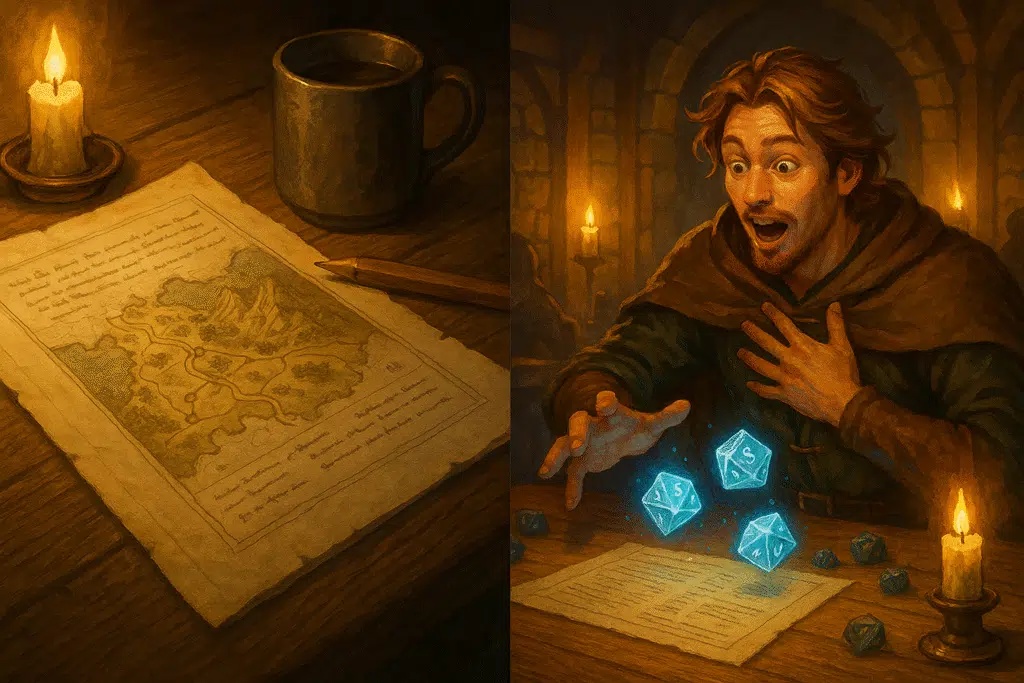
The Preparation-Spontaneity Balance
Preparing Just Enough Without Overplanning
The most vibrant roleplaying experiences strike a delicate balance between preparation and spontaneity. Too much preparation can create brittle narratives that break when players inevitably make unexpected choices. Too little can lead to meandering sessions that lack meaningful structure. Finding the sweet spot between these extremes requires strategic preparation focused on possibilities rather than predetermined outcomes.
Effective preparation focuses on creating rich situations rather than specific scenes. Instead of scripting an expected conversation, prepare the motivations, secrets, and pressures affecting each character involved. This approach creates the conditions for organic interaction while maintaining flexibility about exactly how those interactions might unfold. Know what information needs to be revealed, but remain open to multiple pathways for that revelation.
Physical environments benefit from similar flexible preparation. Rather than plotting exact movements through a location, prepare distinctive features that could become relevant in various situations—the creaky floorboard that might betray a sneaking character or provide warning of an approaching enemy, the cluttered desk that could conceal important documents or provide improvised weapons in a confrontation. These environmental affordances create opportunities without prescribing exactly how they’ll be used.
Responding Authentically to Unexpected Turns
Even with perfect preparation, roleplaying inevitably produces unexpected moments when players make choices no one anticipated or when random elements like dice rolls create surprising outcomes. These moments often become the most memorable parts of the experience when handled with flexibility rather than resistance.
The key to navigating unexpected turns lies in responding to the underlying motivation rather than the specific action. When a player makes a surprising choice, ask yourself what goal they’re pursuing rather than focusing on how their choice disrupts your plans. This perspective shift often reveals ways to honor their agency while maintaining narrative coherence. If a character unexpectedly attacks someone you’d planned as a long-term ally, perhaps that ally has hidden depths that make the character’s suspicion partially justified, even if misapplied.
Remember that unexpected turns create opportunities to demonstrate that player choices genuinely matter. When you adapt the narrative to incorporate surprising decisions rather than negating them, you reinforce that players are co-creators rather than merely experiencing a predetermined story. This responsiveness builds trust that encourages further creative risk-taking, creating a positive cycle of engagement.
When to Abandon Your Plans for Something Better
Perhaps the most difficult skill in roleplay facilitation is recognizing when your carefully crafted plans should be set aside because something more compelling has emerged organically. This discernment requires both humility and attunement to the emotional energy of the group rather than just the logical structure of the narrative.
Signs that emergent content might warrant abandoning planned material include heightened emotional engagement, increased player proactivity, and unexpected connections being formed between narrative elements. When players lean forward, take more initiative, or build creative connections you hadn’t anticipated, these energetic signals often indicate that the emergent direction holds greater potential than the planned one.
The transition away from prepared material need not be abrupt or total. Look for ways to repurpose prepared elements in the new context. The dramatic confrontation you planned in one location might be relocated. The important non-player character might appear in a different role than originally conceived. The key information might be revealed through different means. This adaptive repurposing maintains the session’s substantive quality while following the group’s organic energy.
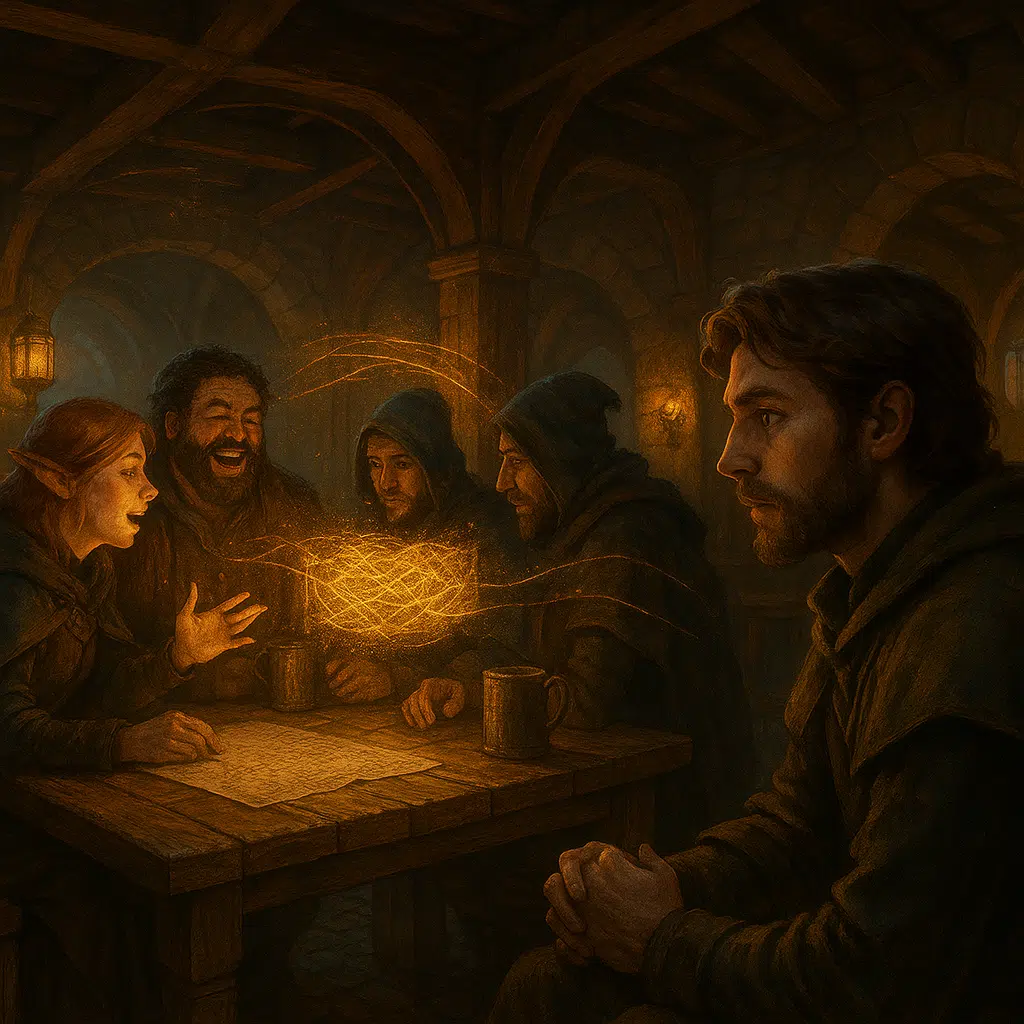
The Listening Roleplayer
Catching Subtle Character Cues Others Miss
The difference between adequate roleplayers and exceptional ones often lies not in what they contribute but in what they notice. Truly attentive participants catch subtle cues that others might miss—a slight change in another character’s speaking pattern that suggests hidden emotion, a briefly mentioned detail that reveals character motivation, or an implied connection that opens narrative possibilities. This heightened awareness creates opportunities for deeper interaction.
Developing this perceptiveness begins with intentional focus on others rather than planning your next contribution. Many roleplayers inadvertently miss important cues because they’re mentally rehearsing their next line or action instead of fully absorbing what’s happening in the moment. The discipline of setting aside your own plans to truly listen transforms your capacity to respond authentically to what’s actually unfolding.
Physical cues often communicate as much as verbal ones. A player who sits up straighter when a certain topic arises, who gestures more emphatically when expressing a particular view, or who makes or avoids eye contact in specific contexts is communicating valuable information about their character’s relationship to the material. Noting these embodied signals allows you to respond to the full range of communication, not just the explicit verbal content.
Building Meaningful Connections Between Characters
The relationships between characters often become the emotional heart of roleplaying experiences, yet many players focus primarily on their individual character development rather than on relationship building. Intentionally creating substantive connections between characters adds a dimension of depth that individual characterization alone cannot achieve.
Effective relationship building begins with identifying potential points of resonance or tension between characters—shared values with different expressions, complementary strengths and weaknesses, or contrasting perspectives on shared experiences. Once identified, these connection points can be gradually developed through scenes that specifically highlight these dynamics rather than merely advancing plot.
Questions serve as powerful tools for relationship development. “What does your character think of mine after witnessing that?” or “How does your character’s background affect how they view this situation differently than mine?” create openings for relationship exploration. These inquiries not only develop immediate connections but often reveal new aspects of each character that might otherwise remain unexplored.
Giving Others the Spotlight Moment They Deserve
Every satisfying roleplaying experience includes moments where each character shines in ways aligned with their unique capabilities and narrative arc. These spotlight moments allow individual expression while strengthening group cohesion, but they rarely happen accidentally. Creating and supporting these opportunities requires conscious attention from everyone involved.
The most obvious approach involves actively looking for situations that allow another character’s distinctive abilities to prove crucial. If someone has created a character with unique knowledge of ancient languages, finding opportunities where that expertise becomes essential demonstrates that their character concept matters. Similarly, engineering scenarios where a character’s personal quest intersects with the group’s journey validates the player’s contribution to the collective narrative.
Less obvious but equally important is how you respond when another character is having their moment. Asking engaged questions, expressing in-character appreciation, or finding ways your character is impacted by their actions all amplify their spotlight moment. These supportive reactions transform what might be a solo performance into a relationship-building experience that strengthens the overall narrative fabric.

The Knowledge Paradox
Playing a Character Who Knows Less Than You Do
One of roleplay’s fundamental challenges is authentically portraying characters who possess different knowledge and perspectives than their players. The player who knows the monster’s weakness must play a character who discovers it through investigation. The player who understands the political machinations must portray a character gradually piecing together the conspiracy. Managing this knowledge differential without breaking immersion requires both technical approaches and psychological discipline.
The most direct technique involves compartmentalizing knowledge—mentally separating what you know from what your character knows. This practice becomes easier with explicit acknowledgment: “I know this is a vampire vulnerable to sunlight, but my sheltered nobleman has never encountered supernatural creatures.” This explicit recognition of the knowledge gap makes it easier to set aside out-of-character awareness when making in-character decisions.
Beyond compartmentalization, focus on your character’s process of discovery rather than the facts themselves. Instead of thinking, “I need to pretend not to know about the secret passage,” consider, “How would my cautious scholar methodically search this room?” This process-oriented approach naturally produces more authentic roleplaying than simply avoiding using knowledge your character shouldn’t have.
Using Dramatic Irony to Heighten Tension
Rather than viewing the gap between player and character knowledge as a problem to overcome, skilled roleplayers leverage this differential to create dramatic irony—situations where the audience knows something the characters don’t. This narrative technique, when consciously employed, creates compelling tension rather than breaking immersion.
Players can deliberately make suboptimal choices that align with their character’s limited information while knowing the choice may lead to complications. This isn’t about deliberately sabotaging the character but about embracing the narrative richness that emerges when characters act according to their understanding rather than omniscient knowledge. A character investigating a suspect the player knows is innocent creates scenarios that wouldn’t exist if the character somehow magically knew what the player knows.
The key to effective dramatic irony lies in making the character’s choices believable within their knowledge constraints rather than obviously foolish. The noble investigating the wrong suspect should have legitimate reasons for their suspicion based on their limited information. The scholar missing the significance of an artifact should have a plausible alternative interpretation. These justified misunderstandings create tension without making the character seem incompetent.
Separating Player Knowledge from Character Actions
Beyond individual decisions, the knowledge paradox affects how characters develop over time. Players naturally accumulate understanding of game mechanics, setting details, and optimal strategies that their characters realistically wouldn’t possess. Managing this growing knowledge differential becomes increasingly important as campaigns progress.
One effective approach involves character-justified evolution—finding in-world reasons for growing capabilities that align with the player’s increased knowledge. A character might study fighting techniques that happen to align with the player’s growing understanding of combat mechanics. A character might develop relationships with mentors who share strategic insights similar to what the player has learned through experience. These narrative justifications maintain immersion while allowing players to apply their developing mastery.
For knowledge that can’t be justified through character development, consider establishing explicit table agreements about certain types of information that remain compartmentalized. Many groups distinguish between “character knowledge” (what the fictional person knows), “player knowledge” (what the real person knows), and “table knowledge” (information everyone agrees to incorporate regardless of whether characters would logically know it). These clear categories prevent both immersion-breaking omniscience and frustrating situations where players artificially limit themselves.
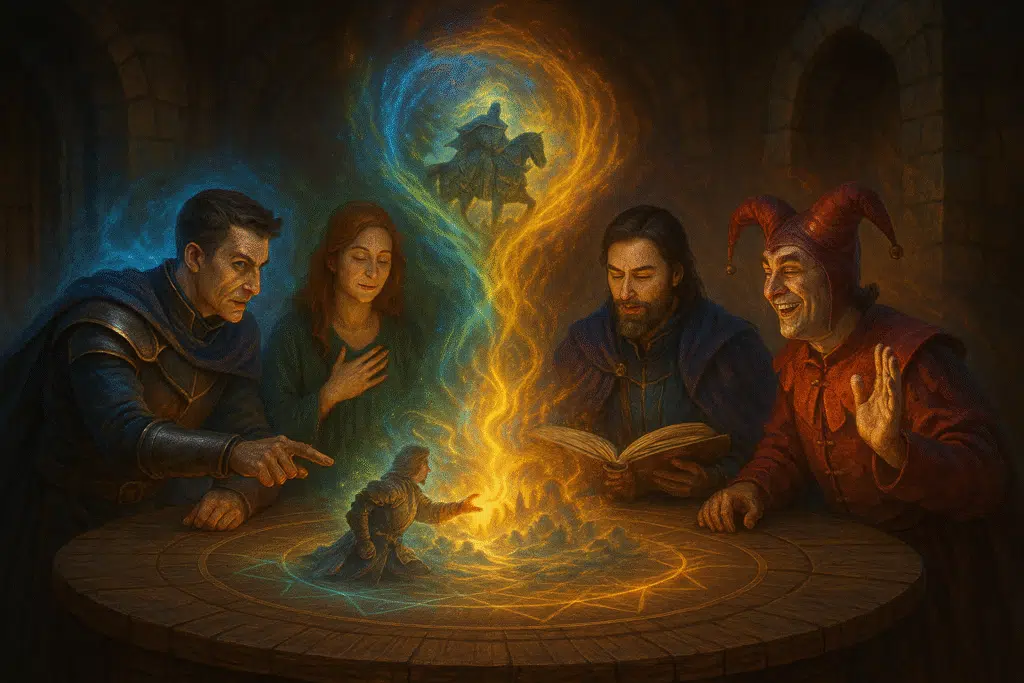
The Social Architecture of Great Roleplay
Creating Space for Different Play Styles
Roleplay groups often contain participants with dramatically different preferences and approaches. Some players seek deep emotional immersion, others enjoy tactical problem-solving, while still others focus on collaborative worldbuilding or humor. Rather than seeing these differences as problems to solve, skilled facilitators recognize them as complementary elements that create a richer collective experience when properly integrated.
The first step in accommodating diverse play styles involves explicitly acknowledging and validating these differences. A simple conversation about what each person enjoys most about roleplaying can transform potential friction into mutual understanding. When someone says, “I really love the strategic elements of overcoming challenges,” while another shares, “I’m here for the emotional relationships between characters,” both preferences become recognized as legitimate rather than competing priorities.
Beyond acknowledgment, structuring sessions to include elements that appeal to different play styles ensures everyone experiences satisfaction. A single session might include a tactical challenge for the strategists, character development scenes for the immersion-focused players, and worldbuilding opportunities for the creatively oriented participants. This intentional variety ensures everyone experiences their preferred type of engagement while also participating in others.
How Group Dynamics Shape Character Decisions
Characters in roleplay don’t develop in isolation—they evolve in response to the others around them, both fictional and real. The unique social dynamics of each group inevitably shape character development in ways both subtle and profound, creating emergent patterns that couldn’t be predicted from individual character concepts alone.
Characters naturally differentiate themselves from others to establish distinct identity within the group. If one character emerges as the cautious voice, another might lean further into risk-taking than they otherwise would. If someone portrays a character with elaborate speech patterns, others might develop more concise communication styles to create contrast. This natural differentiation process usually happens unconsciously but creates more balanced and complementary character ensembles.
Beyond differentiation, characters often develop in response to the emotional needs of the group. A player might notice that tense situations consistently benefit from moments of levity, leading their character to develop more humor than originally conceived. Another might recognize that their team lacks a mediating presence, gradually evolving their character to fill this social need. These adaptations reflect the socially responsive nature of roleplay as an art form that develops through collective interaction. This collaborative character evolution works regardless of setting complexity—whether you’re exploring the intricate world-building of High Fantasy vs. Low Fantasy campaigns or simpler contemporary scenarios, characters naturally adapt to serve group dynamics and story needs.
When Real Friendships Deepen Through Fictional Experiences
Perhaps roleplay’s most profound and least discussed aspect is how shared imaginative experiences strengthen real-world relationships. The vulnerability, creativity, and collaborative problem-solving inherent in roleplay create unique bonds between participants that often extend beyond the game itself, transforming casual acquaintances into lasting friendships.
This transformation happens partly because roleplay reveals aspects of personality that might remain hidden in ordinary social interactions. The quiet professional who reveals unexpected wit through their character, the seemingly confident extrovert who displays touching vulnerability in dramatic scenes—these glimpses behind social masks create more authentic connections between players who witness each other’s creative expressions. These revelatory moments highlight why skilled facilitation matters so much, as explored in Where the Rules End: How GMs Shape Stories That Stick, which examines how game masters create the conditions for these meaningful personal discoveries to emerge safely
Beyond revelatory moments, shared emotional experiences—even fictional ones—create genuine bonds. Neurologically, the brain processes imagined emotional experiences similarly to real ones, meaning the group that collectively navigates a tense negotiation, celebrates an unexpected victory, or mourns a character’s sacrifice develops emotional connections similar to those formed through real-world experiences. This phenomenon explains why many roleplaying groups that begin as casual entertainment evolve into supportive communities that endure for years or even decades.
The boundaries between ourselves and our characters are more permeable than we often realize. When we step into another’s mindset with intention and care, something transformative happens—not just within the game, but within ourselves. Every character we embody leaves fingerprints on our consciousness, and every scene we share creates connections that transcend the table. Perhaps this is roleplay’s greatest gift: the recognition that we are all, in our way, practicing the art of becoming—trying on perspectives, testing boundaries, and discovering new facets of our humanity through the safe harbor of play. In these shared stories, we find not just entertainment, but glimpses of our larger potential.






